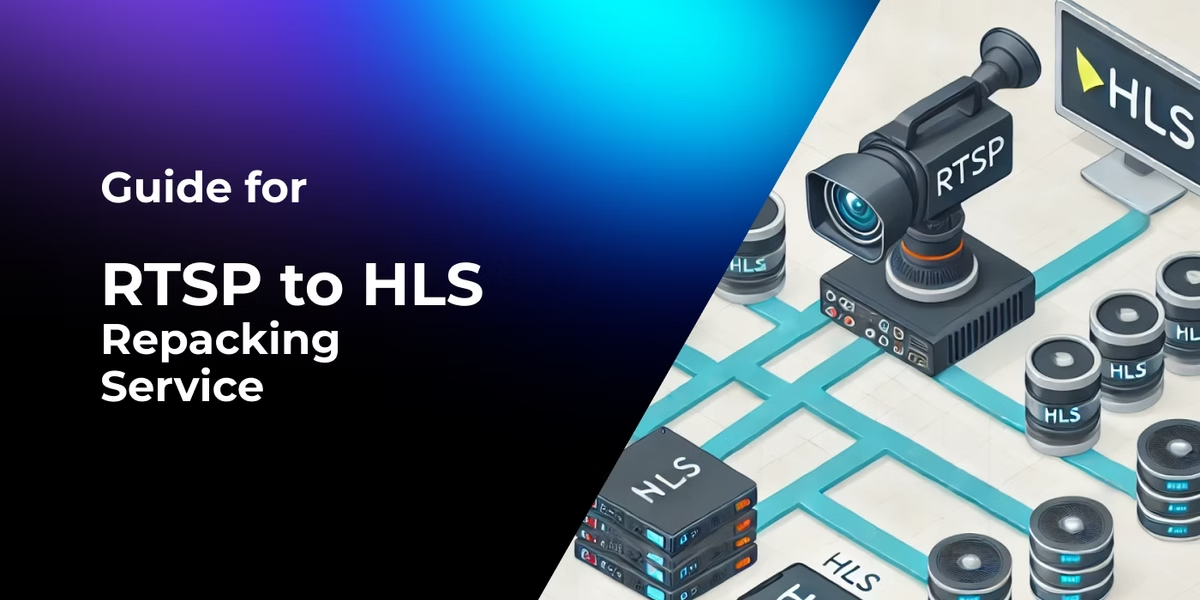
RTSP to HLS repacking service

RTSP (Real-Time Streaming Protocol) is widely used for live video streaming, especially in IP cameras and surveillance systems. However, RTSP isn't natively supported by most web browsers, making it less versatile for modern applications.
On the other hand, HLS (HTTP Live Streaming) is a browser-friendly protocol supported across devices and platforms.
By leveraging FFmpeg and Nginx, you can efficiently repack RTSP streams into HLS for seamless streaming. Here's how this powerful duo works.
What is FFmpeg?
FFmpeg is a robust multimedia framework capable of processing, converting, and streaming audio and video in various formats. It plays a crucial role in transforming RTSP streams into HLS playlists (.m3u8).
What is Nginx?
Nginx is a high-performance web server and reverse proxy that serves as the delivery mechanism for the HLS files generated by FFmpeg. It ensures efficient file hosting, supports cross-origin requests, and scales to handle many simultaneous viewers.
How FFmpeg Helps Repack RTSP to HLS
FFmpeg repackages the RTSP stream into the HLS format without re-encoding, which saves computational resources and reduces latency.
Use FFmpeg to process the RTSP input and generate HLS segments.
Example Command
ffmpeg -i rtsp://admin:Multimedia@10.14.25.151:8554/ch01 \
-c:v copy -c:a copy -f hls -hls_time 1 -hls_list_size 6 \
-hls_time 1 -hls_list_size 6 -hls_flags delete_segments \
/var/www/streams/AV05SD082a.m3u8Key Parameters:
- -c:v copy:Copies the video codec without re-encoding.
- -c:a copy:Copies the audio codec without re-encoding.
- -hls_time:Sets the duration (in seconds) of each HLS segment.
- -hls_list_size:Defines the number of segments in the playlist.
FFmpeg continuously processes the RTSP stream and generates a live.m3u8 playlist and media segments.
How Nginx Serves HLS Streams
Nginx acts as the web server that delivers the HLS files to clients. Configure Nginx to serve HLS files with CORS support.
Configuration File Location: /etc/nginx/sites-enabled/strapi.conf
Sample Configuration
server {
listen 80;
server_name 10.14.25.18;
location /streams/ {
types {
application/vnd.apple.mpegurl m3u8;
video/mp2t ts;
}
root /var/www;
add_header Cache-Control no-cache;
add_header Access-Control-Allow-Origin *;
}
}- The types block specifies MIME types for .m3u8 and .ts files.
- The Access-Control-Allow-Origin * header supports cross-origin requests.
Restart Nginx after configuration
sudo systemctl restart nginxClients can now access the HLS stream through a URL like:
http://10.14.25.18/streams/stream.m3u8Conclusion
Repacking RTSP streams into HLS using FFmpeg and Nginx is an effective solution for delivering high-quality video streams to a wide range of devices. This setup ensures compatibility, scalability, and efficiency, making it ideal for applications like IP camera streaming, live broadcasting, or multimedia projects.
With HLS support, AV Studio allows developers to create projects without the need for third-party plug-ins. Just integrate into your project AV Studio a video element that supports HLS playback.
Gallery

Optimized Proxy Server for Seamless AV Integration | AVgator AV Studio
Streamline your AV projects with seamless integration using AVgator AV Studio. Our optimized proxy server ensures fast, reliable, and efficient performance for all your audiovisual needs.
Unlocking Cross-Origin Communication: CORS Policies in HTML5 Interfaces
Cross-Origin Resource Sharing (CORS) is a vital security mechanism in web technologies, including HTML5-based interfaces created with Crestron Construct, Crestron CH5, or AVGator® Studio for Crestron control systems. It ensures that requests from a control interface (e.g., a Crestron panel or Crestron One on iPad) to external servers or APIs are handled securely. While similar to traditional web applications, the use of CORS in Crestron interfaces has its specific challenges and solutions due to
Need help with this integration?
Our technical team can help you set up and configure this integration for your specific needs.
Contact Technical Support